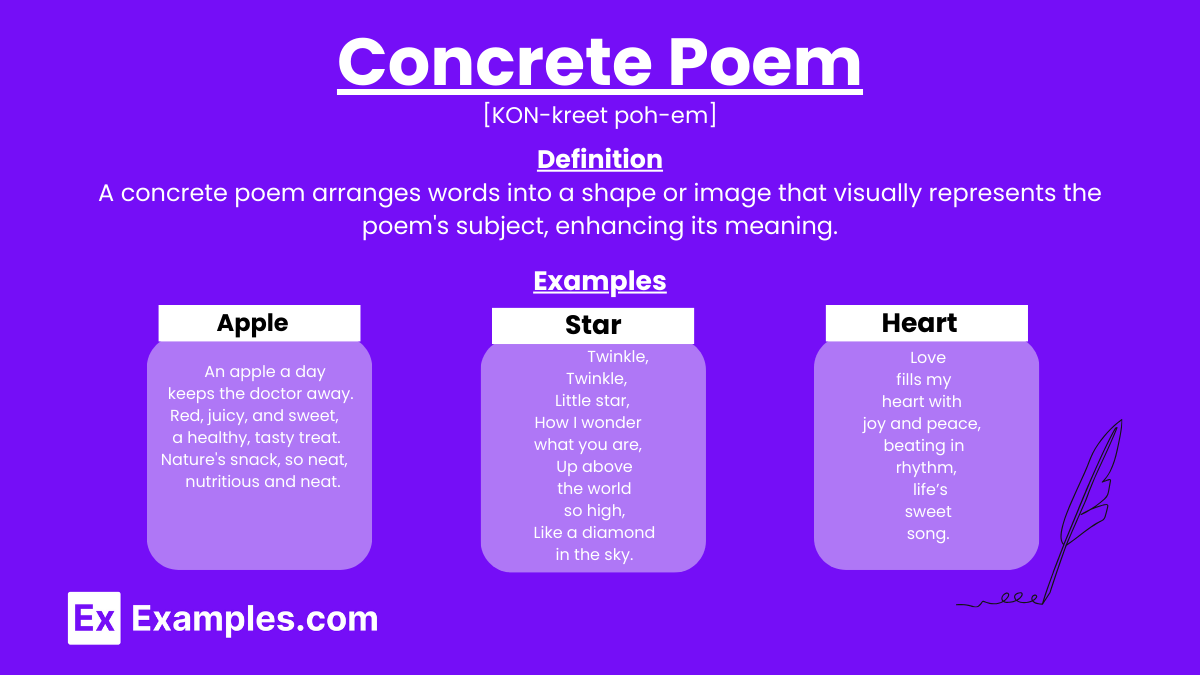

Poetry is a beautiful form of expression, a medium that allows us to communicate our deepest thoughts, feelings, and experiences in a creative and engaging way. Among the many types of poetry, one stands out for its unique visual appeal and imaginative use of language: the concrete poem. This article will delve into the world of concrete poetry, providing examples, a step-by-step guide on how to write one, and answers to frequently asked questions.
A concrete poem is a type of poetry where the visual arrangement of words on the page forms a significant part of the poem’s meaning. The text is arranged to create a shape or pattern that enhances the theme or subject of the poem, blending visual art with literary expression.
Concrete poetry, also known as visual or shape poetry, uses the arrangement of words on the page to convey meaning in addition to the text itself. Here are some common types of concrete poems:
The text is arranged to form a specific shape or image that relates to the poem’s content.
Words, phrases, or entire poems are arranged to create a visual image that depicts the subject of the poem.
The arrangement of the text follows a specific pattern or design, which enhances the meaning or theme of the poem.
The visual elements, such as typography, layout, and color, are used to add layers of meaning to the text.
The use of different fonts, sizes, and styles to create a visual impact that complements the poem’s theme.
Incorporates drawings or visual elements created with words to form part of a larger artwork.
Modern concrete poetry that may include interactive elements, such as digital media or installations.
Creating a concrete poem involves both linguistic creativity and visual layout. Here’s a step-by-step guide to formatting a concrete poem, along with tips to enhance its impact:
Poem Text:
Arrangement:
Love
is a
journey
that leads
to the heart’s
deepest desires.
Concrete poetry, or shape poetry, uses the arrangement of words to form a visual image that relates to the poem’s subject. Here are ten engaging examples to inspire students’ creativity.
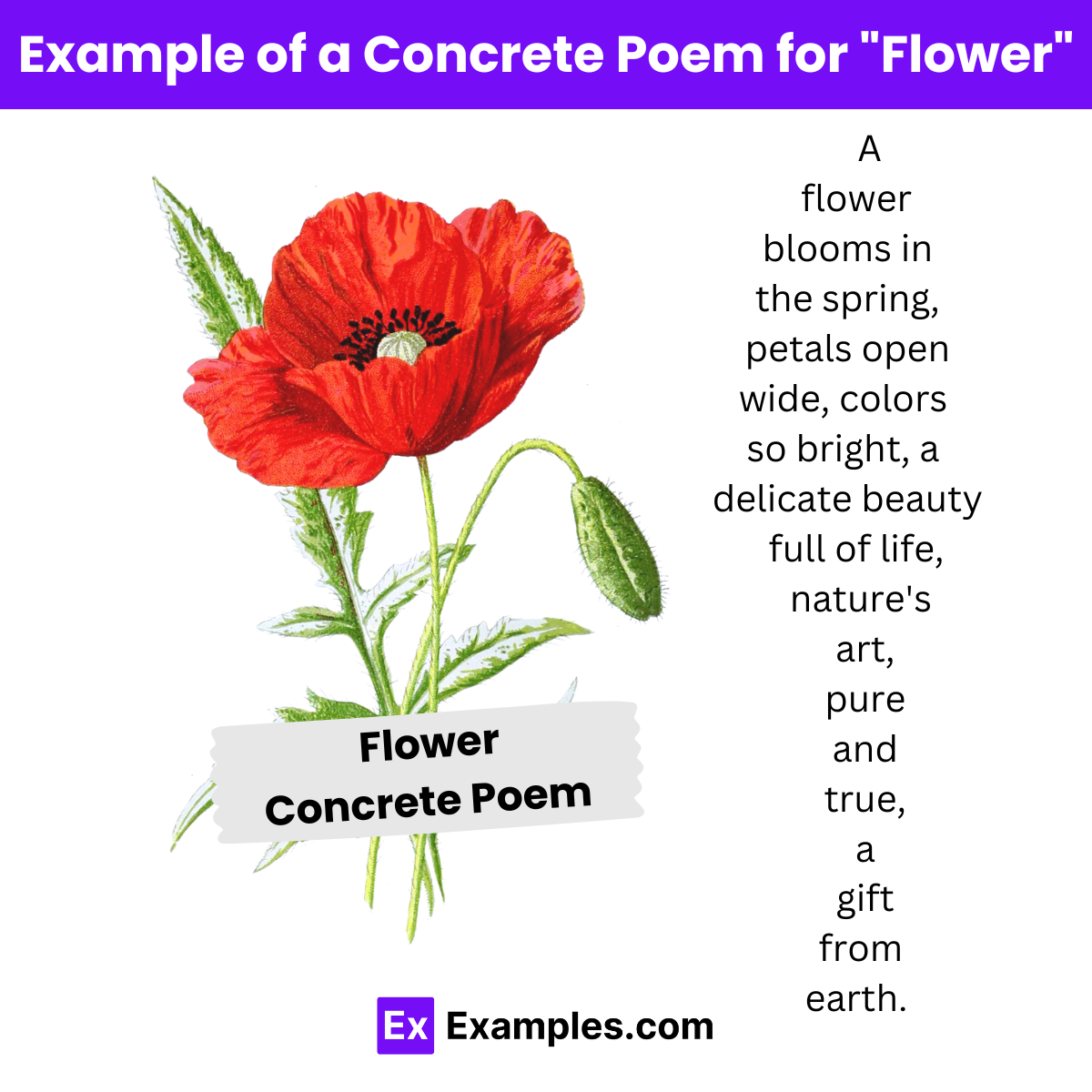
Concrete poetry, also known as shape poetry, creatively arranges words to form a visual representation of the poem’s subject. Here are some flower-themed examples to inspire creativity.
Petals reaching high,
In golden hue so bright,
A sunflower stands tall,
Turning to the light.
Soft petals unfold,
In hues of red and pink,
A rose blooms with grace,
In nature’s tender embrace.
White petals spread wide,
With a sunny yellow heart,
A daisy’s simple charm,
Is nature’s true art.
Elegant and pure,
In white and soft pastels,
A lily’s beauty blooms,
Where serenity dwells.
Colors bold and bright,
In gardens they stand proud,
Tulips in the spring,
Form a vibrant, blooming crowd.
Petals soft as silk,
Pink and white in bloom,
Cherry blossoms drift,
In the springtime’s sweet perfume.
Exotic and rare,
In colors rich and deep,
An orchid’s beauty shines,
In quiet, thoughtful keep.
In shades of purple,
Small and sweetly scented,
Violets dot the fields,
With beauty, they’ve presented.
Petals layered thick,
In shades of pink and white,
A peony blooms large,
In gardens, pure delight.
Golden like the sun,
In gardens they do cheer,
Marigolds stand bright,
Through every passing year.
Concrete poetry, or shape poetry, uses the arrangement of words to form a visual image that relates to the poem’s subject. Here are some heart-themed examples to inspire creativity.
Love beats softly,
In a rhythmic flow,
A heart full of warmth,
In a gentle glow.
In the center of my chest,
Where emotions do rest,
A heart beats strong and true,
Always thinking of you.
In a world of fleeting moments,
One thing remains true,
My heart’s endless love,
Forever for you.
Cracks and fractures deep,
A heart once whole, now torn,
Healing slowly, piece by piece,
In time, it will be reborn.
Melodies of joy and sorrow,
Resonate within,
A heart sings its song,
In harmony with the wind.
Gentle and caring,
With a touch so light,
A heart full of kindness,
Brings hope to the night.
Courage strong and bright,
Facing fears head-on,
A heart that’s brave and true,
Fights until the dawn.
Pure and precious,
With a luster so bright,
A heart of gold shines,
In the darkest night.
Wishes and dreams,
Hopes burning bright,
A heart’s true desire,
Guides through the night.
Thump-thump, thump-thump,
A steady, rhythmic beat,
A heart keeps its time,
In a life, complete.
Concrete poetry, also known as shape poetry, uses the arrangement of words to form a visual image related to the poem’s subject. Here are some football-themed examples to inspire creativity.
Running down the field,
With speed and might,
A player’s goal in sight,
Touchdown under the lights.
Kicks and passes,
Fans cheer and shout,
Teams clashing on the field,
In a football bout.
Leather and laces,
In the air it flies,
A perfect spiral thrown,
Under the clear blue skies.
Guarding dreams,
Protecting the fight,
A helmet keeps safe,
Under stadium lights.
Final yards to go,
Defenders to evade,
Reaching the end zone,
Victories made.
Eyes scan the field,
Reading every play,
A quarterback leads,
Guiding the way.
Whistle blows loud,
Ball soars high,
Kickoff begins,
Under the open sky.
Spirits lifting high,
With chants and cheer,
Cheerleaders rally,
Bringing fans near.
Upright and tall,
Guiding the kick,
Through the goalpost,
Points add up quick.
Players gather close,
Planning the next move,
In the huddle they trust,
Their strategy to prove.
Concrete poetry, also known as shape poetry, uses the arrangement of words to form a visual image that relates to the poem’s subject. Here are some basketball-themed examples to inspire creativity.
Rising high,
Above the rim,
A slam dunk
In the gym.
Bouncing, bouncing,
Across the court,
A basketball in play,
In this favorite sport.
Circular and tall,
The hoop stands proud,
Aiming for the net,
Makes the crowd loud.
From the arc,
A shot so clean,
Three points scored,
A winning team.
Down the court,
Quick and sleek,
Dribble past
Every peek.
At the line,
Steady and calm,
A free throw shot,
In the palm.
Against the glass,
Shots rebound,
The backboard stands,
Sturdy and sound.
Lines and marks,
Define the play,
On the court,
Skills display.
Swish it goes,
Through the net,
A perfect shot,
They won’t forget.
Together they play,
In unison they move,
A basketball team,
With something to prove.
Concrete poetry, or shape poetry, arranges words to form a visual image that relates to the poem’s subject. Here are some volleyball-themed examples to inspire creativity.
High above the net,
With power and might,
A spike comes down,
A winning sight.
Round and ready,
Bouncing with glee,
A volleyball in play,
On sand or gym’s sea.
Stretching tall and wide,
Dividing sides with pride,
The net stands firm,
As players collide.
Tossed in the air,
With precision and nerve,
A powerful strike,
Begins with a serve.
Hands reach high,
Defending the shot,
A block so strong,
Gives all they’ve got.
Reaching for the ball,
A swift, graceful glide,
A player’s quick dive,
Keeps the dream alive.
With a gentle touch,
The ball takes flight,
A perfect set,
For the spike’s might.
Lines mark the way,
Where the game is played,
On the volleyball court,
Skills are displayed.
Arms steady and strong,
Guiding the ball along,
A bump starts the play,
In this thrilling fray.
Together they stand,
In victory and defeat,
A volleyball team,
With hearts that beat.
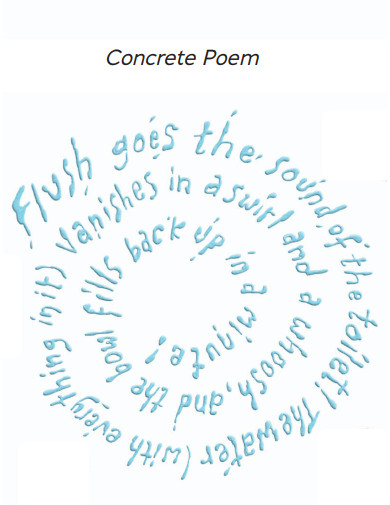
lernerbooks.com
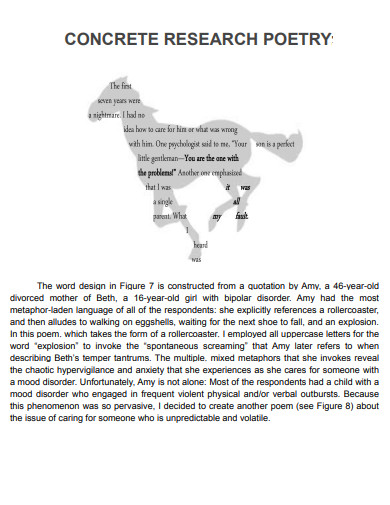
journals.library.ualberta.ca
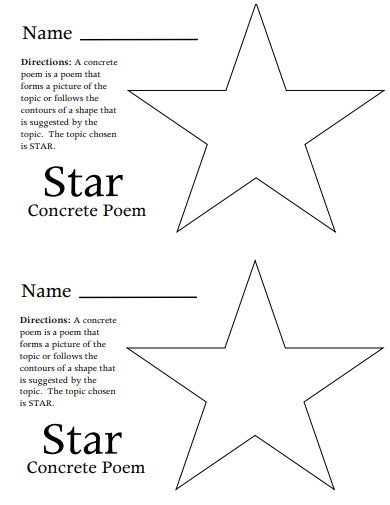
smileifyourhappy.files.wordpress.com
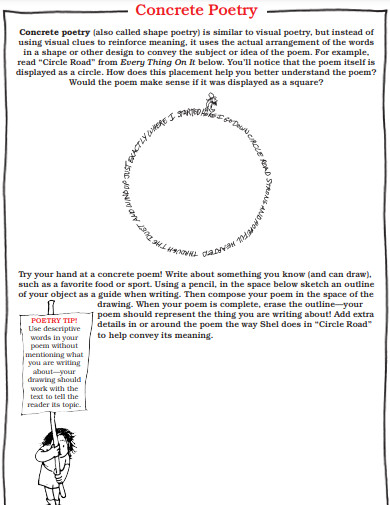
dhjhkxawhe8q4.cloudfront.net
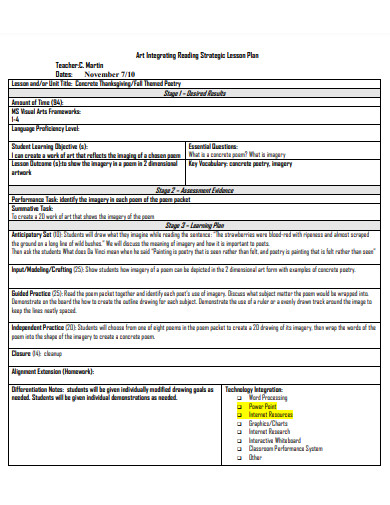
madison-schools.com

hannahspuler.files.wordpress.com
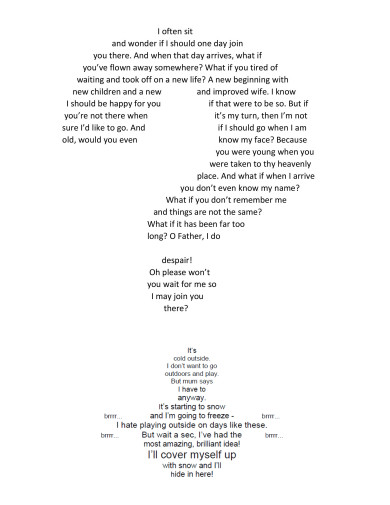
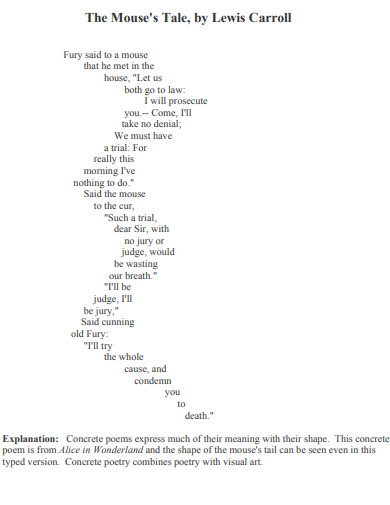
tuactivitytoolkit.files.wordpress.com
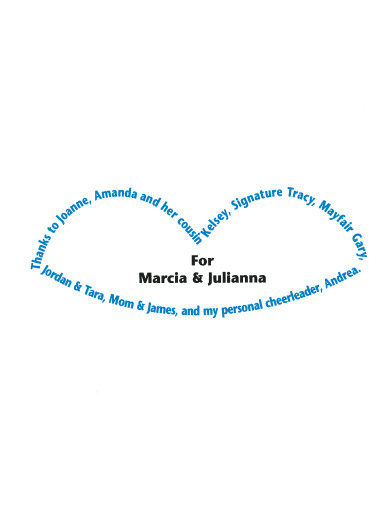
skylineschools.com
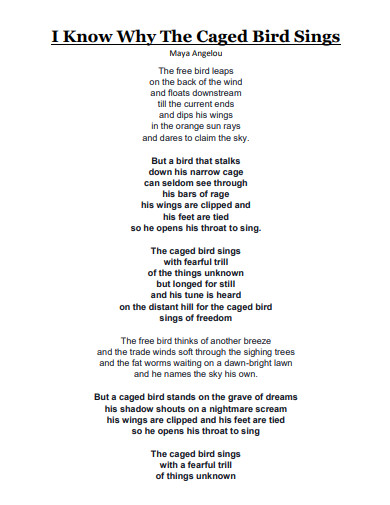
shawsheentech.org
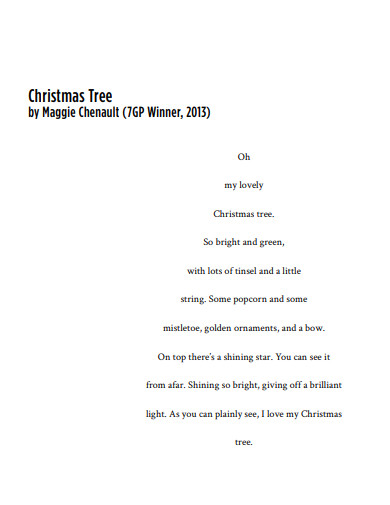 Christmas Tree Concrete Poem Example" />
Christmas Tree Concrete Poem Example" />
static1.squarespace.com
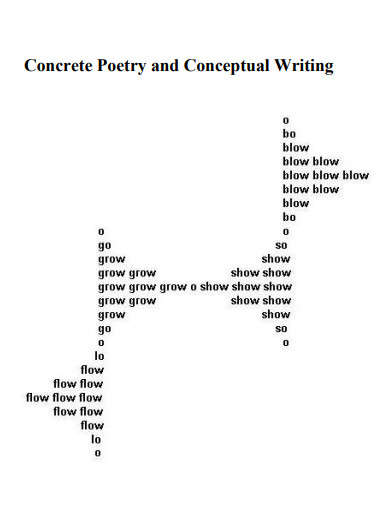
derekbeaulieu.files.wordpress.com
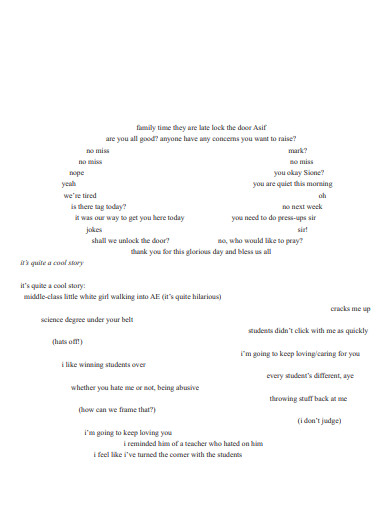
journals.sagepub.com
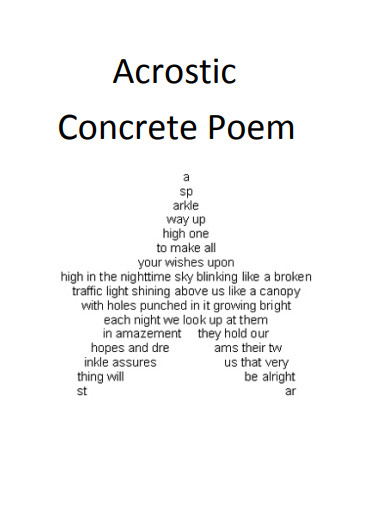
dentonisd.org
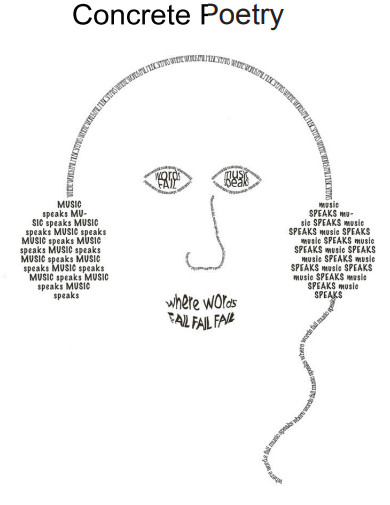
grade6d.weebly.com

nsuworks.nova.edu
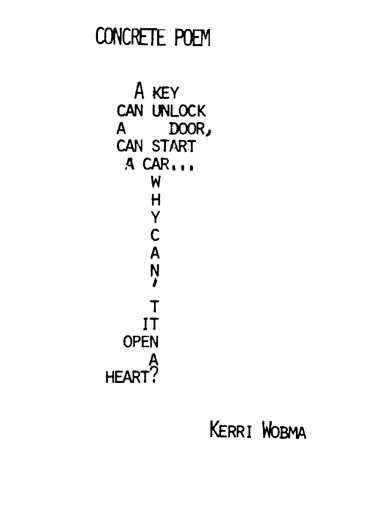
scholarworks.gvsu.edu
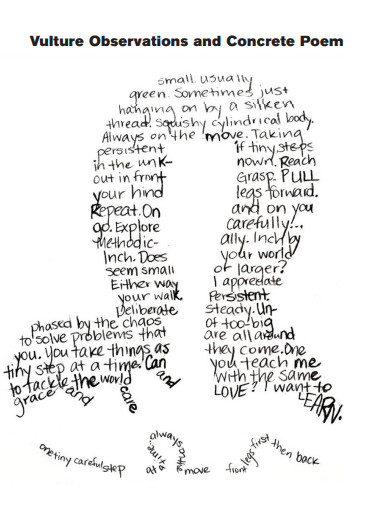
naturalsciences.org
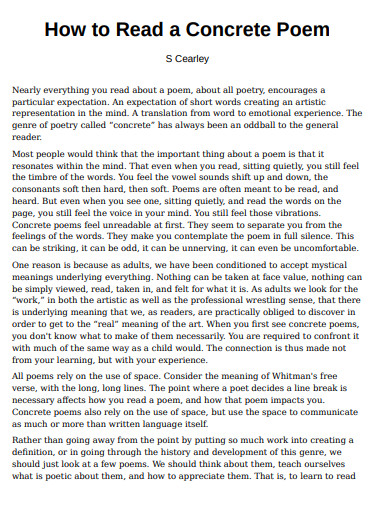
futureanachronism.com
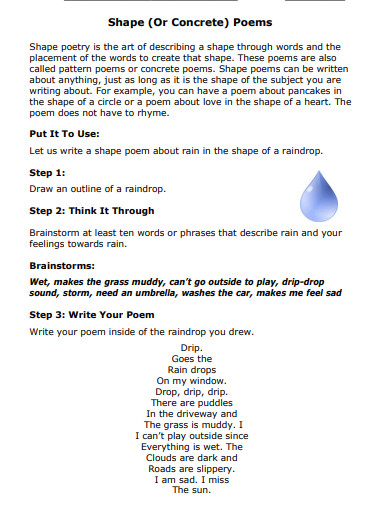
teach-nology.com
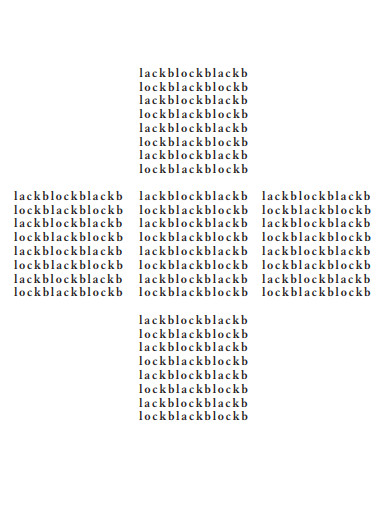
content.ucpress.edu
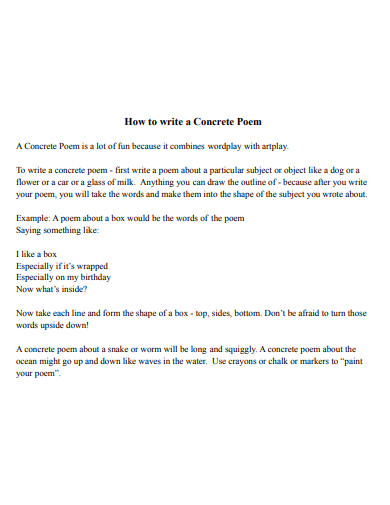
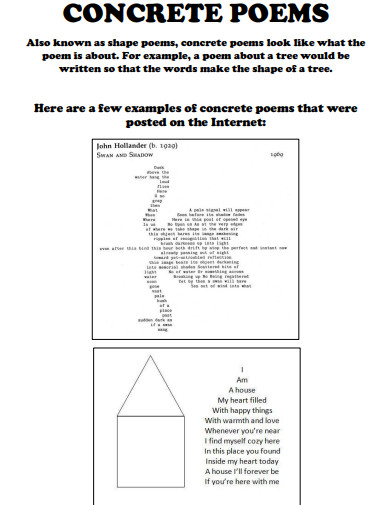
Concrete poetry, also known as shape poetry, functions by arranging words in a way that forms a visual image related to the poem’s subject. This type of poetry combines linguistic elements with visual art to enhance the reader’s experience and engagement. Below is an explanation of how concrete poetry functions, along with examples for better understanding.
Concrete poetry uses the visual arrangement of words to form shapes that depict the poem’s subject. This visual aspect adds another layer of meaning and can make the poem more engaging.
The structure of the poem is crucial. The shape created by the words can convey emotions, themes, or actions related to the poem’s content.
The content of the poem aligns with its form. For instance, a poem about a tree might be arranged in the shape of a tree, and the words used will describe the tree or its significance.
The unique structure of concrete poems attracts readers’ attention and can make the reading experience more interactive and memorable.
Concrete poetry, also known as shape poetry, creatively arranges words to form a visual representation of the poem’s subject. Here are the key rules to follow when creating a concrete poem:
Concrete poetry, also known as shape poetry, combines poetic elements with visual art by arranging words to form shapes that relate to the poem’s subject. Here are some engaging and creative ideas for concrete poems:
Before we dive into the steps, it’s important to note that writing a concrete poem requires a blend of creativity, patience, and a keen eye for detail. It’s not just about crafting a poem; it’s about creating a visual masterpiece with words.
The first step in writing a concrete poem is to choose a theme. This could be anything from a noun, like ‘tree’ or ‘heart’, to a more abstract concept like ‘love’ or ‘freedom’. The theme will guide the shape of your poem.
Next, write your poem. Don’t worry about the shape yet; focus on the words and their meaning. Use literary devices like alliteration and allegory to enhance your poem’s impact. Remember, the poem itself should still be meaningful without the shape.
Once you’ve written your poem, it’s time to design the shape. Sketch out your chosen shape on a piece of paper and try to fit your words into it. This might require some editing and rearranging.
The final step is to finalize your poem. This might involve adjusting the stanza structure, tweaking the wording, or refining the shape. The end result should be a poem that not only reads well but also visually represents its theme.
A concrete poem, also known as a shape poem, arranges words to form a visual image that reflects the poem’s subject.
Concrete poems focus on visual appearance, while traditional poems emphasize rhythm and rhyme.
Subjects with clear, recognizable shapes or themes, such as animals, objects, or emotions, work well.
Choose a subject, outline its shape, and fill the shape with relevant words and phrases.
Yes, a concrete poem can rhyme, but its primary focus is on the visual layout.
Examples include “Easter Wings” by George Herbert and “Apollinaire’s Calligrammes.”
No strict rules exist; creativity in visual and textual elements is encouraged.
They combine visual art with writing, engaging different cognitive skills and fostering creativity.
Yes, concrete poems can be adapted for any age group, from children to adults.
Digital tools like word processors or design software, and traditional tools like pen and paper, are useful.